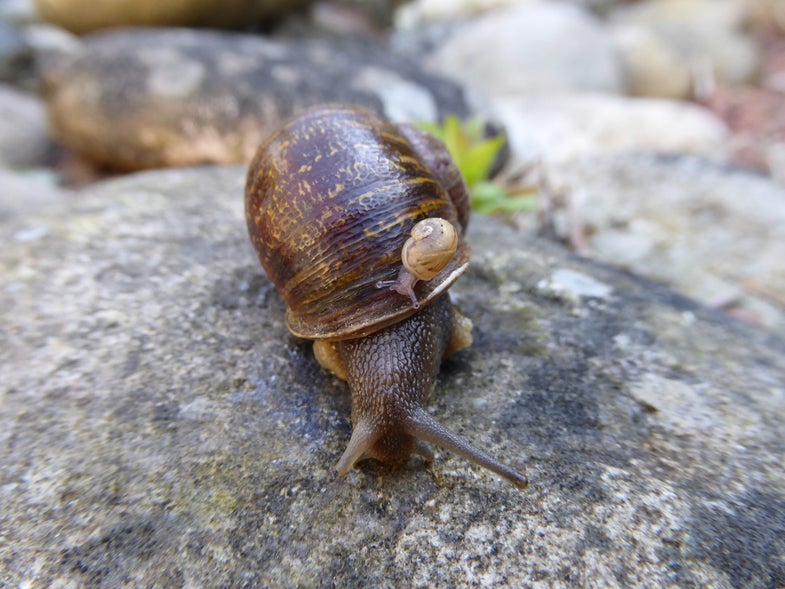Jeremy the lefty snail has now been rejected by two other lefty snails
Scientists found compatible mates for him, but they had sex with each other instead.

Jeremy is alone. He doesn’t fit in with the other snails. We mean that literally: his sex organs do not fit with other snails’ sex organs, so he has no one to mate with.
Poor little Jeremy’s sexy bits are on the left side of his head, whereas most snails have theirs on the right, so biologists at the University of Nottingham put out a call last year to ask lefty snail owners to donate their mucus buddies to science. By helping poor Jeremy get laid, the researchers hoped to discover whether lefty snails produce lefty offspring. Now, alas, both of the potential mates who came to live with Jeremy have rejected him in favor of copiously reproducing with each other.
Now Jeremey is doubly alone.

See, Jeremy (and his lefty buddies) have a rare genetic condition called situs inversus, which is exactly what it sounds like. It means that the snail’s body is basically a mirror image of a normal body. Humans with the condition have their hearts on the right side instead of the left, along with other reversed organs, and should be thankful that our species’ sex organs are centered.
Snails are not so lucky. To have sex, they have to stick two penises into two vaginas—because they’re hermaphrodites and can get it on with anyone. Pond snails (like Jeremy) can’t fulfill the male and female roles simultaneously, because they only have one genital hole, so one acts as the male while the other acts as a female. They can swap roles immediately afterwards so that both end up preggers. Land snails can do it all at once.

But first: the foreplay. Snails will circle around each other for hours, just gettin’ each other revved up for the coital act. They touch tentacles and nibble each other’s genital pores before they squoosh up against each other to get into position. And if you’re a land snail, there’s one more step before you can inseminate each other. It’s called a love dart.
You might be tempted to think that “love dart” is some kind of euphemism. It is not. It is an actual sharp, spiky dart that they shoot at each other. Or more specifically, that one of the snails manages to shoot first in order to inject the other snail with spermicidal hormones so that their partner has fewer offspring. Sex has never been so competitive.
Unlike your typical dart, love darts aren’t shot through the air. Snails, lest we forget, are basically blind. Their little eye stalks can detect light and some movement, but they certainly can’t see well enough to aim a dart from any distance away. Instead, snails stab each other more directly with their love darts, sometimes with enough force to go straight through their lover. A large fraction of the time they miss entirely, and who can blame them. You try stabbing someone with your eyes closed and see how close you get.
After one snail has stabbed the other with its love dart, it’s time for the love-making. This is a much more tender process than the stabbing that came before it. Basically, the snails insert their penises into each other’s vaginas and then just sorta sit there. It’s all very egalitarian. Once they’ve exchanged sperm, both snails can expect to lay a bunch of eggs a couple of weeks later.

Pond snails fortunately don’t have to experience this pain, and instead make love in a far sweeter way: both partners get to play both roles and everyone ends up satisfied (or at least not stabbed). Sadly, Jeremy hasn’t gotten to partake in this intimate mating ritual yet. The biologists studying the snails tried to get everyone in the mood by refrigerating them for three months. Nothing says “let’s get it on” like warming up after a simulated hibernation, so when they emerged all of the snails should have felt that springtime urge. But the snails Lefty and Tomeu weren’t really digging Jeremy, and instead chose to mate with each other. Multiple times.
This is good news for the biologists studying Jeremy, because all they really needed was for two left-spiraled snails to mate. It turns out that two lefty snails do not lefty-offspring make. All of the babies so far—and there are 170 of them—have been normal, right-spiraled snails. And that makes sense, because situs inversus is generally an autosomal recessive gene, meaning it’s not linked to biological sex and you need two copies of the mutated gene to get the left-handed phenotype.
Jeremy is still alone, but he has at least parlayed his sorrow into a healthy social media following. You can find him on Twitter as @leftysnail, so you too can follow the saga of an unloved snail trying to find his place in this world. We are all Jeremy.